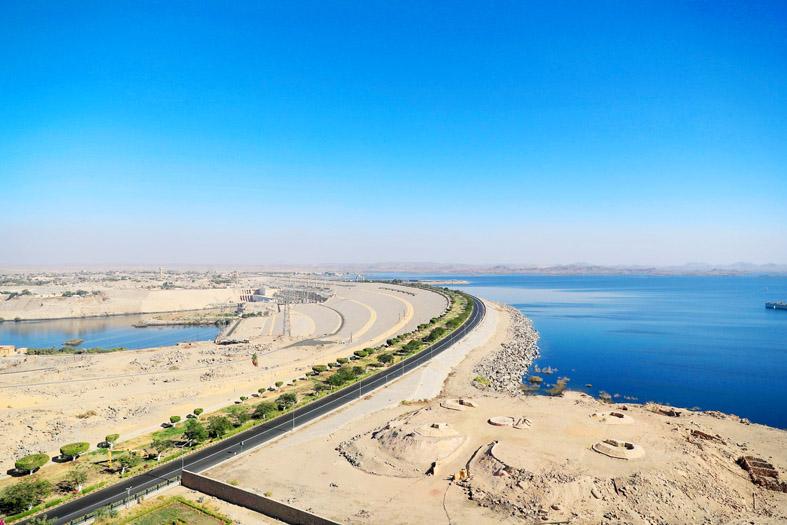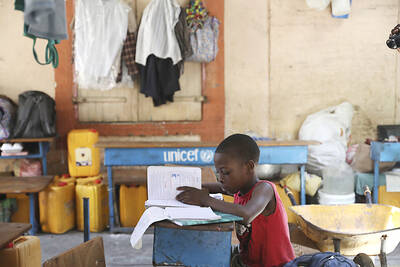Fifty years since Egypt’s ground-breaking Aswan High Dam was inaugurated with much fanfare, harnessing the Nile for hydropower and irrigation, the giant barrier is still criticized for its human and environmental toll.
It is also a stark reminder — amid high tensions today as Addis Ababa fills its Grand Ethiopian Renaissance Dam (GERD) upstream — of just how volatile politics over the life-giving, but finite, Nile water resources can be.
The Aswan High Dam was spearheaded in the early 1950s by then-Egyptian president Gamal Abdel Nasser.

Photo: AFP
Egypt, where the river provides about 97 percent of water for more than 100 million people, is the final section of the Nile’s 6,650km, 10-nation journey to the Mediterranean Sea.
For millennia, Egypt was at the mercy of the seasonal rise and fall of the river, dependent on rainfall in nations far upstream.
However, the 111m-high and 3.6km-wide Aswan High Dam, dwarfing the far smaller Aswan Low Dam built under British rule in 1902, crucially gave Cairo power to regulate the flow.
It was a “very important hydro-political act,” said geographer and author Habib Ayeb, a Nile expert who has taught at universities in Cairo and Paris.
The dam was inaugurated on Jan. 15, 1971, by then-Egyptian president Anwar al-Sadat, three months after Nasser’s death.
For the first time, “an Egyptian president decided to manage the Nile within Egypt,” to develop agriculture and the economy in the country, Ayeb added.
For Egypt, an otherwise desert nation where 97 percent of the population lives along the fertile Nile banks, the dam revolutionized its relationship with the land.
“The dam offered a reprieve to Egyptians by giving them enough water ... and protecting them from the hazards of floods, which could be absolutely catastrophic,” Ayeb said.
It also brought electricity to much of the country, a move that Nasser said was key to developing the nation.
Abdel Hakim Hassanein, who can overlook the river from his home close to the dam, praised its construction.
“We didn’t have electricity before. We used oil lamps,” the 68-year-old said, adding that work at the dam remains a key source of local jobs.
Ethiopia, the second-most populous nation in Africa, today uses similar arguments, saying that its 145m GERD Blue Nile barrier — set to be Africa’s largest hydro-electric dam — is vital to provide power for its 110 million people.
However, Egypt, with the Arab world’s largest population, sees the GERD as an existential threat.
In the 1960s, many Egyptians also saw the Aswan High Dam as a threat to their lives, but in a different way.
The lake behind the dam flooded the homeland of Egypt’s Nubian people, forcing tens of thousands to leave.
“For the Nubians, the High Dam is a symbol of oppression,” rights advocate Fawzi Gayer said.
“It wiped out a civilization,” he added.
Gayer was born just after his family was relocated to a dusty town its Nubian residents call Abu Simbel, or “Displacement.”
“We’re talking about a community with a Nilotic identity that breathes the Nile ... and we have been thrown into the belly of the desert,” Gayer said. “The elderly people died of shock.”
The Nubians’ long-running demand for a “right of return” was included in the 2014 constitution, but their lands have been swallowed by the 355km-long Lake Nasser, which stretches south into Sudan.
For Ayeb, the dam also “proved to be a political bomb.”
Today, Addis Ababa, Cairo and Khartoum are mired in fractious talks over the filling and operation of the GERD.
Ayeb believes Cairo needs a new water policy.
“Egypt must change everything,” he said.

POLITICAL PRISONERS VS DEPORTEES: Venezuela’s prosecutor’s office slammed the call by El Salvador’s leader, accusing him of crimes against humanity Salvadoran President Nayib Bukele on Sunday proposed carrying out a prisoner swap with Venezuela, suggesting he would exchange Venezuelan deportees from the US his government has kept imprisoned for what he called “political prisoners” in Venezuela. In a post on X, directed at Venezuelan President Nicolas Maduro, Bukele listed off a number of family members of high-level opposition figures in Venezuela, journalists and activists detained during the South American government’s electoral crackdown last year. “The only reason they are imprisoned is for having opposed you and your electoral fraud,” he wrote to Maduro. “However, I want to propose a humanitarian agreement that

Young women standing idly around a park in Tokyo’s west suggest that a giant statue of Godzilla is not the only attraction for a record number of foreign tourists. Their faces lit by the cold glow of their phones, the women lining Okubo Park are evidence that sex tourism has developed as a dark flipside to the bustling Kabukicho nightlife district. Increasing numbers of foreign men are flocking to the area after seeing videos on social media. One of the women said that the area near Kabukicho, where Godzilla rumbles and belches smoke atop a cinema, has become a “real

‘POINT OF NO RETURN’: The Caribbean nation needs increased international funding and support for a multinational force to help police tackle expanding gang violence The top UN official in Haiti on Monday sounded an alarm to the UN Security Council that escalating gang violence is liable to lead the Caribbean nation to “a point of no return.” Special Representative of the UN Secretary-General for Haiti Maria Isabel Salvador said that “Haiti could face total chaos” without increased funding and support for the operation of the Kenya-led multinational force helping Haiti’s police to tackle the gangs’ expanding violence into areas beyond the capital, Port-Au-Prince. Most recently, gangs seized the city of Mirebalais in central Haiti, and during the attack more than 500 prisoners were freed, she said.

DEMONSTRATIONS: A protester said although she would normally sit back and wait for the next election, she cannot do it this time, adding that ‘we’ve lost too much already’ Thousands of protesters rallied on Saturday in New York, Washington and other cities across the US for a second major round of demonstrations against US President Donald Trump and his hard-line policies. In New York, people gathered outside the city’s main library carrying signs targeting the US president with slogans such as: “No Kings in America” and “Resist Tyranny.” Many took aim at Trump’s deportations of undocumented migrants, chanting: “No ICE [Immigration and Customs Enforcement], no fear, immigrants are welcome here.” In Washington, protesters voiced concern that Trump was threatening long-respected constitutional norms, including the right to due process. The